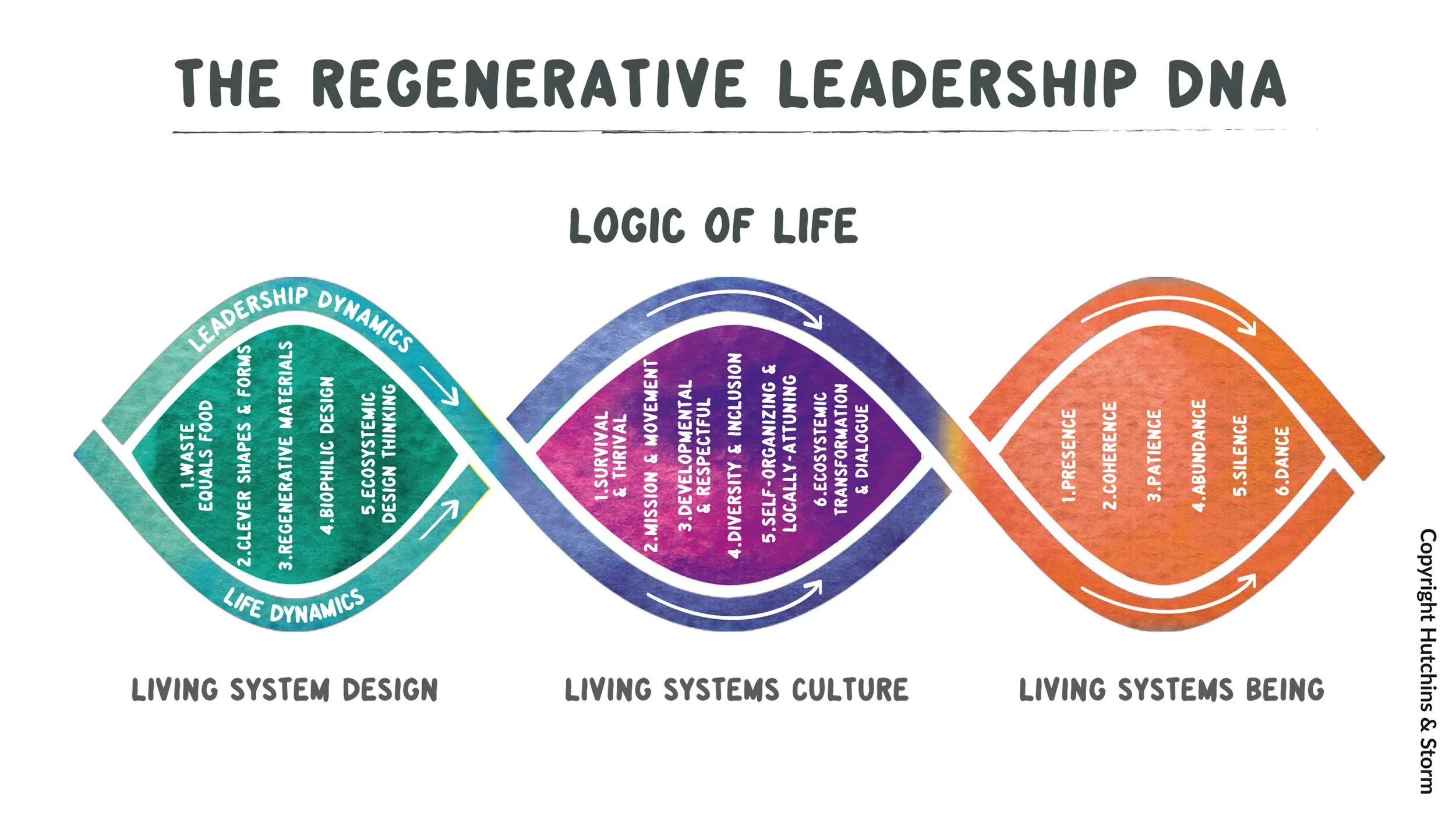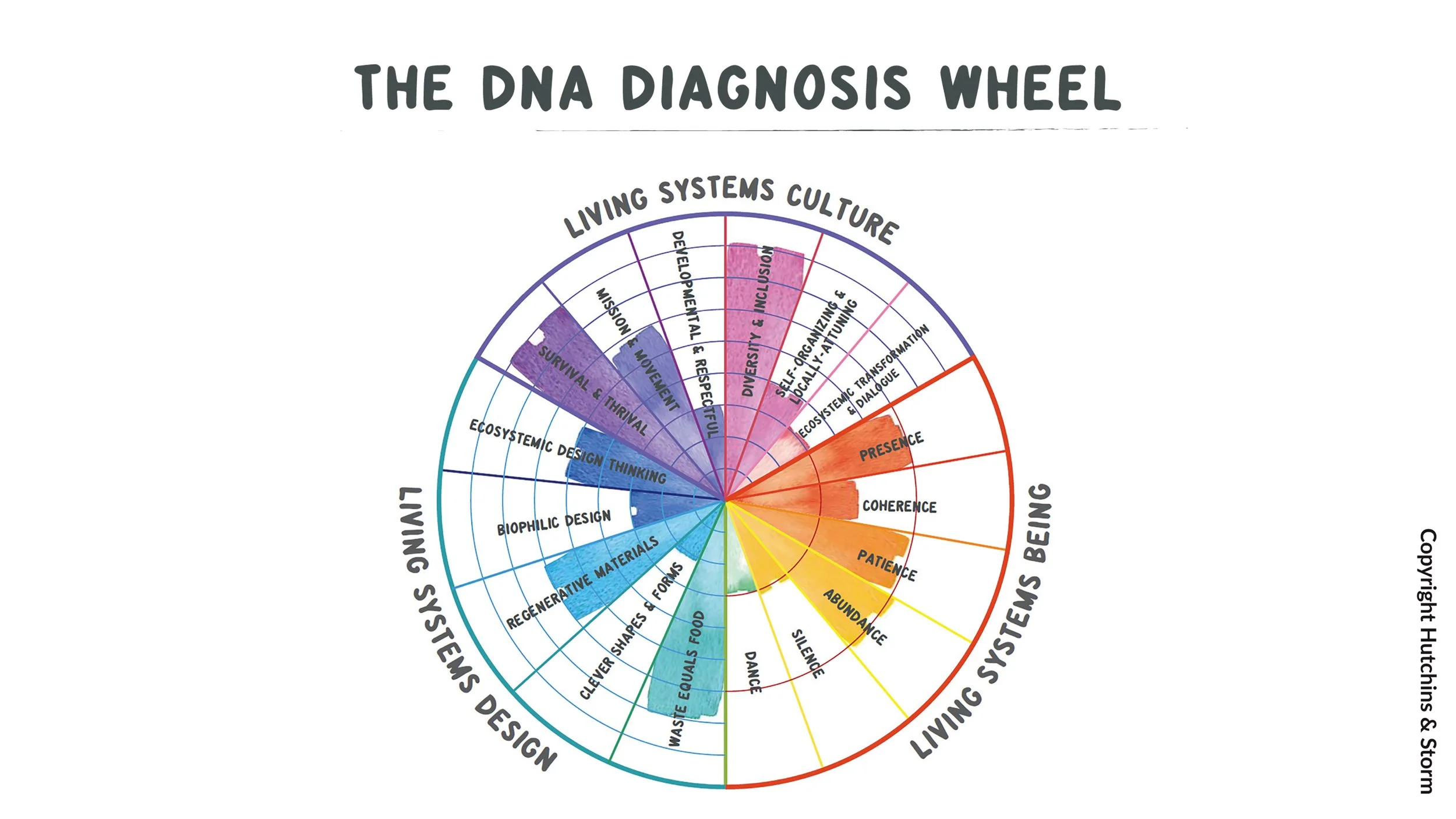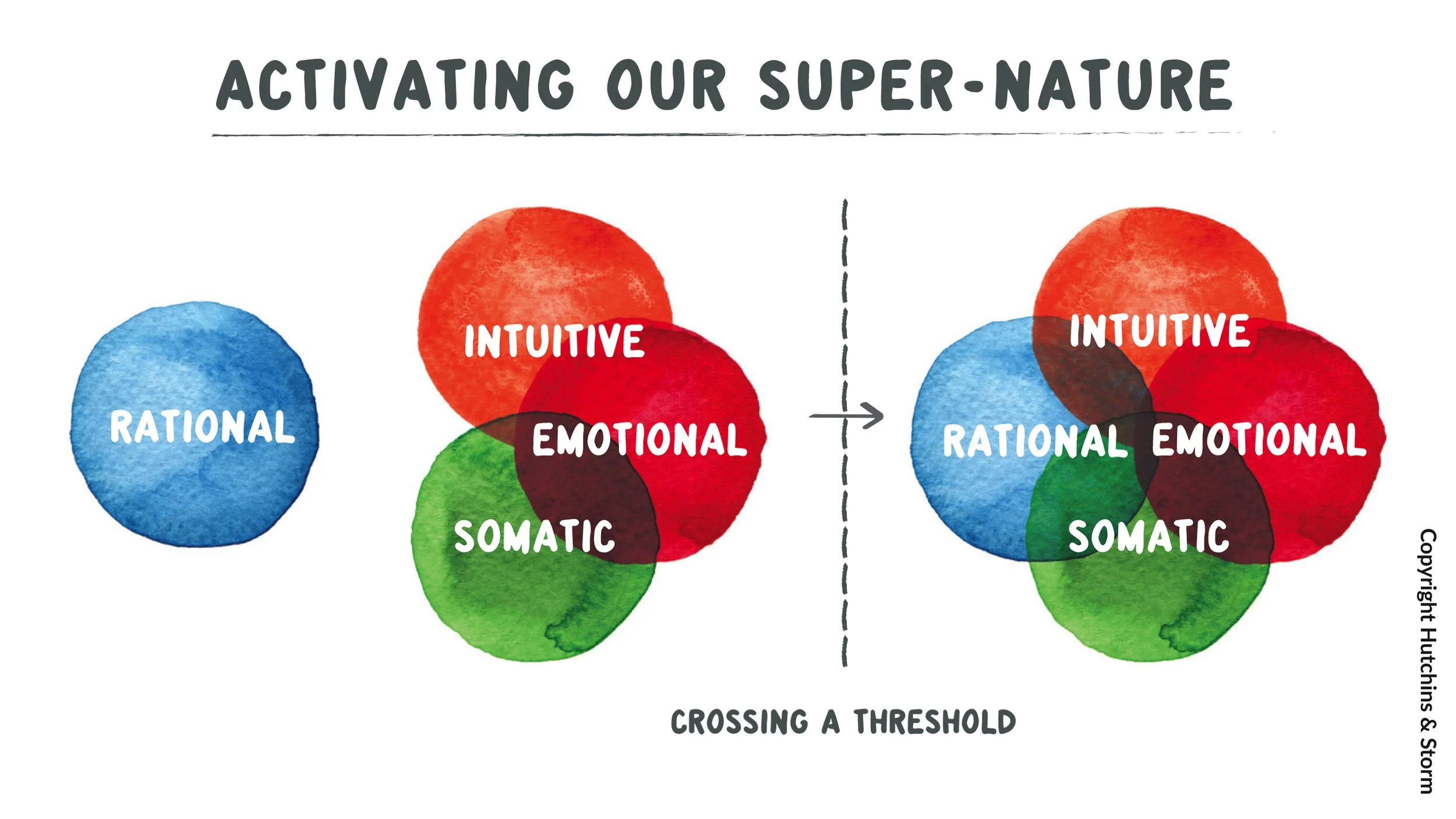Why Regenerative has to be the new norm in business
By Giles Hutchins & Laura Storm
There is no doubt. We are living in a time marked by great upheaval and change, where the breakdown of global systems has become impossible to ignore. Leaders - both political and business - are being forced to cope with rising challenges: pandemics; resource scarcity; high levels of stress in the work place; unpredictable, frequent and disruptive innovations; rampant social inequality; constant competition for top talent; increasing volatility and changing stakeholder expectations; rapid digitization and globalization; mass migrations and refugee populations; fragile supply chains; mounting social tensions; political extremism…The list goes on but you get the picture.
On top of all this, the climate of our planet is changing faster than expected, putting additional critical pressure on all our systems. Our biosphere is collapsing with up to 1000 species going extinct every day.
We have created production systems that are based on a linear, take-make-waste approach focused on immediacy and dehumanization. We have created financial systems based on short-term profit maximization that ignore life and debase human integrity. Our organizational systems are dominated by hyper-competition, power-and-control hierarchies, and rising stress. In our current environment, the few benefit at the expense of the many.
The old systems and structures of a post-industrial hyper-consumerist culture are slowly breaking down. The old ways cannot go on, and through this breakdown, we are witnessing pioneers all over the world birthing the conditions for a new way. These pioneers believe there is a better way – to live and do business. They are rebuilding systems and structures and instilling new business practices that actually contribute to life on Earth rather than destroying it.
For years we have been studying these pioneers, worked with them and witnessed how they impressively through every little action are carving out news ways of doing business, of leading and of living. You can read about these pioneers and our findings in our book Regenerative Leadership. A new paradigm, not only for business but for life on Earth, is being born these years. What these pioneers have in common is how they focus on ensuring their organisations have both an ‘inner’ and ‘outer’ regenerative approach. The ‘inner’ being culture - everything from meetings, feedback, conversations, decision-making, self-managing approaches, adult-adult relations, diversity and inclusion and wellbeing. The ‘outer’ being value propositions – everything from products, services, stakeholder-relations, product design, supply chain, etc. For a business to be on the regenerative journey it ought be attending to both the ‘inner’ and ‘outer’ dimensions so that all aspects of its business seek life-affirming futures that enable the employees, the stakeholders and wider society and the environment to thrive.
What does regenerative mean? Is it the same as sustainability?
We were running Regenerative Leadership retreats and workshops many years ago when seldom folk had even heard of ‘regenerative business’. Now, a few years on, and there is a rising zeitgeist around ‘regenerative’. The term is getting more and more attention and major corporations such as Walmart, Danone, Unilever, General Mills and PepsiCo have started to use the term to communicate aspects of their strategic vision.
But what does the term ‘regenerative’ actually mean, and what about ‘regenerative business’ and ‘regenerative leadership’? Regenerative means to renew, replenish, heal, revitalize. Which, in practice, means to understand and work with the living-system dynamics of the organization and its wider ecosystem; to work in ways that allow the business to become life-affirming. Essentially, ‘regenerative’ is to attune with the way nature works. And ‘regenerative business’ enriches all stakeholders including wider society and the environment; a business that is committed to becoming life-affirming in all its facets, both inner-and-outer: culture, operations, strategy and ecosystem. ‘Regenerative leadership’ is a way of leading that cultivates life-affirming conditions. It is a shift in consciousness from a reductive/mechanistic way of leading into a systemic/living-systems way of leading. We engage in this shift by working with the Logic of Life (which we shall explore in a moment). This is a fundamentally different mind-set from traditional linear mechanistic management theory that much of today’s mainstream leadership approaches are still rooted in. And this is not the same as sustainability. Sustainability, as stated by the Brundtland commission in 1987 means “meeting our own needs without compromising the ability of future generations to meet their own needs.” While ‘sustainability’ is an important aspiration, with the systemic challenges our organisations now face, we need to go further than ‘sustaining’, into working with life, and creating the conditions for life to flourish and creatively adapt both within the culture of the organization and throughout the organization’s relationships and value propositions with its wider stakeholder ecosystem (which includes wider society and the natural ecosystems upon which life depends).
Hence, a regenerative approach works with a living-systems worldview, a quality of leadership consciousness that understands how life works.
This might sound like fanciful utopia to some. Surely business is about the bottom-line? For sure, regenerative businesses need to survive in today’s world, and there is good evidence that shows clear financial benefits in becoming regenerative (see The Global Lamp Index for instance, showing companies that mimic life’s regenerative principles consistently outperform their mechanistic counter-parts). We have spent many years coaching leaders on the ‘business case for regenerative’ to help meet the scepticism it invokes in many of us, and in our book Regenerative Leadership we provide tools to help in this regard. This is not just about survival, it’s also about thrival – to attract and retain high-quality talent, to innovate, out-perform, adapt and evolve in increasingly volatile times. This is simply good business sense, especially amid a societal shift that seeks a deeper sense of meaning, purpose, engagement and creativity in the workplace.
It is only natural, that as ‘regenerative’ becomes more popular, there can be some confusion or misunderstanding around what ‘regenerative’ actually means in practice, when applied to leadership and organizational development. Hence the reason for the book Regenerative Leadership which spells out in detail the complete regenerative DNA model required for regenerative leadership and regenerative business. In summary, there are 3 levels of learning from living-systems:
1) Living Systems Design;
2) Living Systems Culture;
3) Living Systems Being
In brief:
1) Living Systems Design: upon sensing in to how living systems work, we find certain life dynamics, patterns and principles. We can apply these principles and patterns to how we design our products, services, processes, places and economic models. This is the exciting, and revolutionary, space of biomimicry, industrial ecology, circular economics, regenerative design, cradle-to-cradle, biophilic design, bio-innovation, doughnut economics, regenerative economics, and more.
2) Living Systems Culture: as well as applying living-systems insights and systemic-leadership to the design of our processes, products and places, we can explore a shift in our organizational cultures from organization-as-machine to organization-as-living-system. This is the space of complex adaptive systems applied to organizational development, adult developmental psychology, systemic leadership and systemic coaching, self-managing team dynamics, purpose-driven business, adult-adult coaching culture, shifting power-dynamics, and more.
3) Living Systems Being: this shift from reductive to systemic ways of leading and operating, involves a shift in our consciousness, a shift in our ‘being’. The very practice of being-in-nature is scientifically proven to help us become more systemic, empathic, integrated and balanced. Through various practices we can learn to more deeply attune with life, by opening up into our deeper truer nature, while opening into more of how life really is. This is a life-long journey towards wholeness, and is the nutritious soil from which regenerative leadership grows.
Apply all three levels of living-systems and you have embarked on the Regenerative Leadership Journey.
Those already on this journey know that this is first-and-foremost about a shift in consciousness, which can be neatly articulated as a shift from separateness to interconnectedness, and yet there is nothing neat-and-tidy about this journey of a lifetime which requires us to open into our deeper truer nature, individually and collectively, while opening into how life works.
The 7 key principles of the logic of life
So let’s explore how we can take learning from living systems to help our organizations become more regenerative, through 7 principles we call the Logic of Life. These 7 principles are informed by science (from a range of scientific disciplines such as biomimicry, facilitation ecology, evolutionary biology, complexity theory, living systems theory, regenerative design, complex adaptive systems thinking, ecological psychology, quantum physics, and more), and are also inspired by indigenous wisdom and other ancient wisdom traditions.
In brief, these 7 principles of the Logic of Life are:
1) Life is life-affirming: This is the over-arching principle. Life creates conditions conducive to life. The Regenerative Leader seeks only life-affirming activities and outcomes, being watchful for anything that could be toxic, life-denying, degenerative.
2) Life is ever-changing and responsive: Change is an inevitable aspect of life we can embrace for the opportunity and leverage it offers us for learning, adaptation, resilience and evolution. Life learns and adapts through emergent, developmental and evolutionary dynamics.
3) Life is relational and collaborative: Everything in life consists of inter-relating, interconnected systems nested within each other. Understanding these interconnections frees our perception from seeing and thinking in silos and instead into systems. Life is full of relationships; systems nested within systems. From the cells in our body, to our neighbourhood, organization, society and economy, relationships abound. Sensing the relational nature of our organizations helps us notice stuckness, flow and nodal points for leveraging emergent change.
4) Life is synergistic and diverse: Life thrives on diversity – there wouldn’t be life without diversity! Monocultures of sameness or group-think undermine creativity, innovation, adaptability and resilience. Likewise tensions of difference act as crucibles for learning and development.
5) Life is cyclic and seasonal: Life unfolds through ebbs and flows of cycles and seasons. We are all cyclical beings in need of the processes that all seasons bring: The emergence of spring, the intensity of summer, the letting go in autumn, and the deep restoration and reflection of winter. Our inner and outer ecosystems need all phases to thrive.
6) Life is flows of Energy & Matter: Everything flows; bloodstreams, rivers, psychological energy, materials, transportation. Life depends on innate ecosystem flows and cycles that enable recycling, reuse and renewal. There are innate ecosystem processes that life depends upon, and as such everything flows in a cyclic interconnected way. Designing and operating with this understanding of energy flows enables us to recycle, reuse and renew in ways that do not undermine life’s ecosystems.
7) Life is pervaded by a Living Systems Field: Both shamanic and scientific evidence points to an all-pervasive field, a ground-of-all-being that informs all form. We have been brought up in an age where the understanding of this field is largely absent from how we see the world. As we step-change into Regenerative Leadership Consciousness, we sense the interconnectedness of all life and recognize this field of interconnection.
In our workshops and learning journeys with leaders and organizations we apply this living-systems lens to all aspects of the business, from business transformation, strategy development, customer journey design, culture change, branding, team performance, organizational renewal, and agile ways of working, so the organization can become a thriving living-system that works with life, while unlocking the brilliance of its people.
One such business we’ve been working with is Vivobarefoot, which helps people connect with nature through providing high-performance minimalist shoes and nature-connection experiences. Vivobarefoot has been on a regenerative business journey with us for a year now, and its great to see the organization shift from a top-down silo’ed traditionally structured business into a vibrant living-system which embodies ‘regenerative’ both within its culture (by helping people connect more with their own inner-selves and with others through regenerative practices and self-managing methods) and wider throughout its diverse business ecosystem (by helping its stakeholder community engage on this regenerative journey). Vivobarefoot is on an exciting expansive journey with a mission to trailblaze the regenerative business movement and showing how profits can be made in regenerative ways that benefit their entire ecosystem of stakeholders - including the ecosystem upon which all life depends.
Where do I start?
We know it can feel overwhelming to embark on a regenerative journey and therefore we’ve tried to make it easier for you by creating the Regenerative Business DNA framework.
This Regenerative DNA assessment model embraces both the inner and outer technologies, tools, and consciousness that are required for the new regenerative business paradigm to unfold. It’s a unifying framework that integrates vast bodies of research, different domains, and specialist methodologies – connecting the dots instead of creating yet another silo-approach.
We have beta-tested our DNA model of Regenerative Leadership in our coaching and consulting work with leaders from myriad organizations (from small social enterprises through to massive corporations). We have showcased it at international conferences, seminars and workshops. And we have introduced it into our many conversations with practitioners and seasoned specialists working in this emergent field of living-systems applied to leadership. It is clear: There’s a readiness for a holistic model that equally addresses the inner and outer aspects of how to lead and thrive in this next stage of human civilization.
Two questions have guided our work on this framework for next-stage Regenerative Leadership:
How can we be truly life-affirming in our collective way of doing business?
How do we reclaim nature within us and around us in our modern-day urbanized lives?
The DNA framework consists of 3 main elements of learning from living systems we mentioned earlier: 1) Living Systems Design; 2) Living Systems Culture; 3) Living Systems Being – and provides inquiry questions for each section for you to assess where there are areas you ought to start to focus on during your regenerative journey.
Activate your Super-Nature for your continued journey
Those already on this regenerative journey will know that this is first-and-foremost about a shift in consciousness, which can be neatly articulated as a shift from separateness to interconnectedness, and yet there is nothing neat-and-tidy about the journey. It’s an organizational journey as well as a personal journey. On an individual journey you need to activate your Super-Nature to be able to hear, see, feel and analyse everything around you. You need to dare move beyond analysing the progress or health of your organization in excel sheets and instead tap into a greater wisdom.
As a culture, we no longer feel a deep empathic connection with life and the ecological systems that sustains all life on this planet. Instead we primarily focus on outer forms of technological innovation and material progress, while deprioritizing inner wellbeing and consciousness.
The separation of inner (mind) and outer (matter) creates a wounding duality that divorces us from the immense richness of knowledge and wisdom we can only tap into when our inner-outer ways of knowing are integrated and we dare tap into what we call our Super-Nature. Even in this century, many of us don’t know what it means to have a strong inner connection, or how we feel in our own body about certain situations. Do you? Do you know how it feels to be strongly anchored within; at peace and grounded in yourself?
Many leaders today deem bodily reactions and insights as irrational and unreasonable. Our relationship with nature’s innate wisdom may often be seen as hippy-dippy and not to be taken seriously. Intuition is something that is not really understood, and viewed as questionable. Any such irrational thinking we might mock as second-rate or woo-woo. In any given situation, many of us go immediately to our brains, to analyze the situation, while disregarding any intuitive insight or gut-feeling. We react (one might say ‘habitually re-act’) instead of taking a pause, breathing deep, and addressing a challenging situation wisely.
We have unwittingly removed ourselves from ourselves and out of our natural reality! Just look at the way we approach living. Have you ever looked to outside comfort - a new gadget, shopping spree, special food, a weekend getaway, an extreme sport experience, maybe even a date or an affair - when feeling confused or troubled inside? Have you ever put in more hours at work in an attempt to feel (temporarily) good or worthy? While we busy ourselves with outer ‘doing’ we are numbing our inner ‘being’.
Activating our super-nature is about tapping in to our full potential by drawing on our whole-body intelligence, beyond the rational, analytical and mechanistic tendencies we have been trained in. It’s about opening up to a greater wisdom than the rational and analytical left-hemisphere of our brain allows.
What we have spent years working on is bringing an approach to business that meets busy executives where they are at and enables themselves, their teams and their organizations and ecosystems to embark on a Journey of Regeneration, which enables them to come alive and their organizations to thrive amid increasingly volatility. This regenerative leadership journey results in more resilient, innovative, purposeful, agile organizations that attract and retain high quality talent and deliver truly meaningful products and services into society. This is the future of business, and it glowing brighter and strong by the day now.
Organizations such as Vivobarefoot, Houdini, Patagonia, Pukka Herbs, North Star Housing and many more that we case study in the book are forming part of a new way, a regenerative way that celebrate and works with life. This is the future we all know in our hearts is not only possible, but the only viable pathway ahead.
This is a process of ‘becoming’, not a one-off hit or neat-and-tidy change-management plan or 10-step process; it can be messy, full of eddies and undercurrents as it’s also a process of allowing us to be who we truly are and not play a role or wear a mask. It’s a challenging learning journey which is well-worth enduring.
It may be easier to continue doing what you’ve always done, and it may seem sensible amid all this uncertainty and volatility to stick with what you are comfortable with. But in the long run it eats you up inside, weakens you and undermines your organization’s vitality and its stakeholder ecosystem.
We hope you will join us among regenerative pioneers sooner rather than later.
Laura Storm is the Founder of Regenerators and Regenerators Academy and a global expert on Regenerative Leadership and Business and has led multiple international organizations including Copenhagen Climate Council and Sustainia. Awarded the title "Worldchanger" by Greenbiz, named one of the 30 leading women within sustainability and regeneration by Sustainable Brands, a World Economic Forum Young Global Leader and co-author of the much appraised book Regenerative Leadership.
Giles Hutchins is a pioneering practitioner, executive coach and senior adviser at the fore-front of the [r]evolution in regenerative leadership. Previously held corporate roles - Head of Practice for KPMG, and Global Head of Sustainability for Atos (150,000 employees, over 40 countries). He is author and co-author of several leadership and organizational development papers, and the books The Nature of Business (2012), The Illusion of Separation (2014), Future Fit (2016), Regenerative Leadership (2019) and Leading by Nature (2022).




